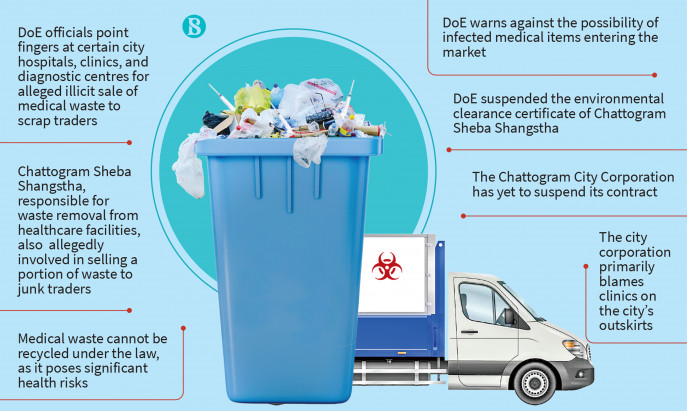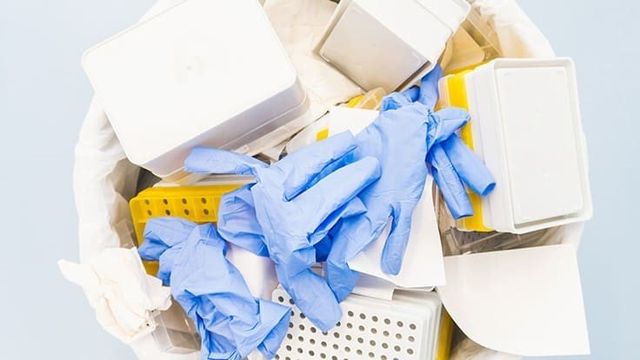Protecting Well-Being: Unveiling the Essence of Professional Medical Waste Removal
Protecting Well-Being: Unveiling the Essence of Professional Medical Waste Removal
Blog Article
Stay Ahead of Rules: Professional Guidance on Medical Garbage Disposal
In a globe where the health care industry is frequently progressing, it is necessary for medical centers to stay in advance of policies when it comes to the appropriate disposal of medical waste. With strict guidelines and regular regulatory modifications, it can be challenging to browse the complexities of this process. Nevertheless, with experienced guidance, centers can ensure compliance and alleviate threats associated with incorrect waste disposal. From understanding the different classifications of clinical waste to executing the ideal collection and partition approaches, this conversation will supply actionable ideas and important understandings to assist centers remain in advance of regulations in the ever-changing landscape of medical garbage disposal.
Understanding Medical Waste Categories
Comprehending clinical waste classifications is vital for appropriate disposal and administration in health care centers. Medical waste refers to any waste produced by healthcare tasks that might posture a hazard to public health and wellness or the environment. It is essential to categorize clinical waste precisely to ensure its secure handling, therapy, disposal, and transportation.
There are several groups of medical waste that healthcare facilities require to be knowledgeable about. One of the most typical categories include transmittable waste, pathological waste, sharps waste, pharmaceutical waste, and chemical waste. Each classification has details standards and regulations for its appropriate management and disposal.
Pathological waste refers to human cells, body organs, or body parts that require special handling and disposal. Pharmaceutical waste consists of run out, extra, or infected medicines that require careful handling and disposal.
Staying Up-To-Date With Regulatory Modifications
Staying present with regulative modifications is vital for medical care centers to make certain conformity and correct management of medical waste disposal. medical waste removal. With policies continuously progressing, it is necessary for medical care centers to stay up-to-date to avoid penalties, penalties, and possible damage to the atmosphere and public health and wellness
To stay in advance of regulative modifications, medical care centers ought to develop a system for monitoring and tracking updates. This can be done by registering for regulatory e-newsletters, attending workshops and meetings, and proactively taking part in industry associations. Additionally, centers ought to designate an employee or group in charge of remaining notified and sharing details to relevant stakeholders.
Normal communication with governing companies is also vital. Health care centers need to develop relationships with neighborhood, state, and federal firms to ensure they recognize any kind of changes in guidelines that may impact their waste monitoring techniques. This can be done with normal meetings, involvement in public remark periods, and positive involvement with regulatory firms.
Additionally, healthcare facilities must consider partnering with waste monitoring companies that specialize in clinical waste disposal (medical waste disposal services with WasteX). These companies are frequently fluent in the latest regulations and can provide guidance and assistance to ensure compliance
Implementing Proper Collection and Partition Techniques
To successfully take care of clinical waste disposal, healthcare centers must develop proper collection and partition techniques according to governing guidelines. Implementing these methods ensures the secure handling and disposal of possibly harmful materials, shields the atmosphere, and reduces the risk of infections and injuries to healthcare employees and the general public.
Correct collection and partition techniques entail the usage of designated containers and classifying systems. Healthcare centers must offer plainly labeled containers for various types of clinical waste, such as sharps, contagious waste, pharmaceutical waste, and non-hazardous waste. These containers ought to be color-coded and clearly marked to prevent confusion and advertise easy recognition.
Furthermore, healthcare facilities need to train their team on the appropriate procedures for collecting and setting apart medical waste. This consists of educating them on the various types of waste, the appropriate containers to utilize, and the relevance of complying with guidelines and standards. Normal training sessions and correspondence course need to be conducted to ensure that team member continue to be up-to-date on finest practices.
In addition, medical care centers ought to develop a system for regular collection and disposal of medical waste. This might involve partnering with accredited waste management firms that specialize in medical waste disposal. These companies will ensure that the accumulated waste is transported and dealt with in compliance with regulatory demands.
Selecting the Right Disposal Approaches

Incineration is just one of the most common and next effective approaches for disposing of specific kinds of medical waste, such as pathological waste and sharps. It includes the controlled combustion of waste at heats, decreasing it to ash. Nonetheless, incineration can launch unsafe pollutants right into the air and add to air contamination.

Chemical treatment includes the usage of chemicals to sanitize and counteract the waste. Microwave treatment uses microwave energy to heat and decontaminate the waste.
Making Sure Conformity With Paperwork and Training
After very carefully thinking about the proper disposal approaches for medical waste, medical care facilities need to make certain conformity with regulations and decrease ecological effect by carrying out reliable documents and training treatments. This step is important in maintaining a lasting and risk-free atmosphere for both healthcare employees and the basic public.

Health care workers who deal with clinical waste must receive ideal training on waste segregation, handling, and disposal procedures. By providing thorough training, health care centers can equip their team to make educated decisions and lessen the risk of incorrect waste disposal.
Conclusion
In verdict, staying ahead of laws in clinical waste disposal is critical for health care centers. medical waste removal service. Recognizing the different groups of clinical waste, staying upgraded with governing changes, applying proper collection and segregation approaches, choosing the suitable disposal approaches, and guaranteeing conformity through documentation and training are all important steps. By adhering to these standards, health care organizations can properly manage and dispose of clinical waste in a secure and liable way
From recognizing the various categories of medical waste to executing the ideal collection and partition approaches, this conversation will certainly give actionable tips and valuable insights to help facilities stay in advance of laws in the ever-changing landscape of clinical waste disposal. - medical waste disposal services with WasteX
The most usual categories consist of infectious waste, pathological waste, sharps waste, pharmaceutical waste, and chemical waste. Health care facilities must provide plainly labeled containers for different kinds of medical waste, such as sharps, contagious waste, pharmaceutical waste, and non-hazardous waste. Health care facilities should establish an extensive his explanation system to videotape and track all elements of medical waste disposal, including kinds of waste produced, amounts, and disposal methods made use of. Healthcare workers that take care of clinical waste should get ideal training on waste segregation, managing, and disposal treatments.
Report this page